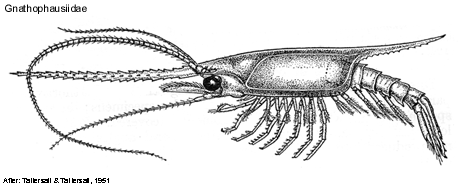 |
||||||
|
|
|
|
|
|
Mysidacea: Families, Subfamilies and TribesKenneth MelandGnathophausiidae Udrescu, 1984 Diagnostic description. Head. Carapace well developed, anterior and posterior margins with thorns and spines. Rostrum elongated (spear-shaped, three edged, and triangular in cross section). Eyes normally developed. Antenna (antenna 2) scale with apical suture or without apical suture, outer margin serrated, without setae, without terminal spine. Labrum symmetric. Mandible left mandible lacinia mobilis well developed to lacinia mobilis reduced or absent (right mandible armed with fixed cusp in position of the lacinia mobilis), spine row absent, molar process well developed. Maxillule (Maxilla 1) endopod with two articles. Thorax. 1st maxilliped exopod absent, or small, unarticulated. 2nd thoracopod developed as a gnathopod, exopod reduced. 3rd-8th thoracopods endopod with distinct carpus and propodus, propodus unsegmented. Branchiae on thoracopods present (outer side of coxa bearing a club-shaped process, armed with long setae, hidden within the foliaceous gills). Marsupium composed of seven pairs of oostegites. Abdomen Abdomen pleural plates well developed (fringed with backwardly projecting ventral spines). 6th & 7th abdominal somites incompletely fused. Female pleopods biramous. Uropod endopod setose around entire margin, statocyst absent; exopod with distal articulation, outer margin entire (terminating in a short spine). Telson apex entire to lateral margins constricted. Generic composition. Gnathophausiidae contians 2 genera (10 species): Gnathophausia W.-Suhm, 1875 (8 species); Neognathophausia Petryashov, 1992 (2 species). Remarks. The Gnathophausiidae are meso- and bathypelagic mysids, recorded from all oceans of the world. They are the only mysids in which a luminous organ has been described, seen as a simple gland producing a luminous secretion, situated on the maxilla's expod. Along with Lophogastridae and Eucopiidae the Gnathophausidae exhibit many primitive characters such as thoracic gills, seven pairs of oostegites, incomplete fusion of the sixth and seventh abdominal somites, large, natatory female pleopods, primitive mandibles in the non-developed right lacinia mobilis, and absence of a statocyst in the endopod of the uropod. In addition the Gnathophausiidae display a primitive maxillule supporting a two-segmented endopod. The genus Neognathophausia is not recognized by Casanova et al. (1998), who have retained G. ingens and G. gigas within the Gnathophausia.
Cite this publication as: 'Meland, K. (2002 onwards). Mysidacea: Families, Subfamilies and Tribes. Version 1: 2 October 2002. https://crustacea.net'. |
|
|
|
|
|
|
|
|
|
Copyright © Australian Museum, 2002 - 2003
Australian Museum website
